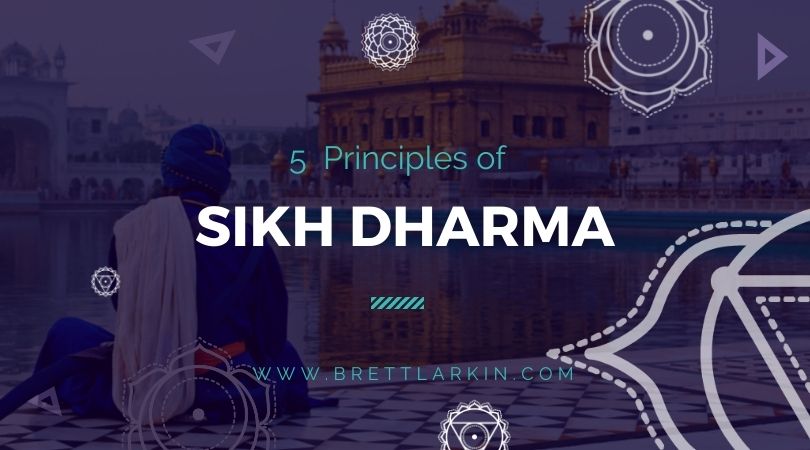Turbans, chanting, meditation and worship of the feminine are just the beginning of the linkage between Kundalini Yoga and the Sikh faith. But, like, what is Sikhism exactly? In this article, we’ll uncover the wisdom of sikh dharma, examine what the beautiful Sikh tradition has to do with Kundalini sadhana, and have a look at the Sikh way of living. Get ready to inspire your yogic lifestyle and open your mind!
Sikh Dharma Meaning
Sikh means “seeker of truth.” Dharma is a word you may already have come across during your Yoga journey. It is a term that has evolved over many years. For Sikhs it means the “path of righteousness” or also the “spiritual path towards union with the Divine”. Hence Sikh Dharma is often referred to as the spiritual practice of one who is seeking truth. You could look at it as a religion that is inviting everyone to experience the Divine within.
Sikh Dharma History
Sikhism is an Indian religion revealed through the teachings of ten Gurus. It originated in the Punjab region of India around the 15th century CE. Over time, it has evolved into one of the largest organized faiths with about 24 million Sikhs around the world. It now is a religion that has not only its own ethics and places of worship (known as gurdwara), but also its own Sikh scriptures and festivals.

And while Sikh Dharma has been around for quite some time, its major boost in popularity wasn’t until Yogi Bhajan traveled to the West to share his teachings of Kundalini Yoga in the late 1960s. Being a Sikh and leading by example he inspired many of his students to open their minds to Sikh Dharma.
Sikh Dharma Philosophy & Beliefs
The core beliefs of Sikh Dharma are derived from the Guru Granth Sahib, which is a collection of teachings of the Sikh Gurus and various other Saints from other religions including Hinduism and Islam. It is THE foundational holy scripture in Sikh history and treated as a living guru among Sikhs. Its first installation was in the Temple of Amritsar (the second largest city in the Indian state of Punjab) in the early 1600s.
One of the most outstanding principles of Sikh Dharma is the importance of seva (being of voluntary service to others) while also practicing simaran (remembrance of God or the Divine). It is the goal or ideal to be a saint soldier throughout your life (known as sant sipahi), which refers to someone who is able to combine these two – their spiritual qualities as well as initiative to take courageous action.
- Universal Equality
In Sikh religion it is believed that there is only one God, and that all people worship the same God. Hence, the belief is that all people are equal. You might have seen Sikhs holding community meals for the poor without questioning their religious background or beliefs. Everyone is treated the same. For that reason, Sikhs keep their gurdwaras open to everyone.
- Living Grace
Similar to Bhakti Yoga, Sikh Dharma is a practice of devotion. Sikhs believe in the concept of mukti (liberation) which we know from Yoga – similar to achieving samadhi or nirvana.
In order to achieve liberation, Sikhs focus on the Divine grace. It is through a continuous effort of self-discipline and truthful living that one attains mukti. Hence meditation and being of service play a huge role in Sikh Dharma.
- Karma and Reincarnation
As with other religions, karma in Sikhism is associated with the consequences of one’s behavior. One can gain good and bad karma throughout their life. Sikhs believe that all beings – humans and animals alike – have an atma (soul) and are part of the cycle of reincarnation. The karma gained throughout life determines the body that the atma is born into after death. To build up good karma throughout life one performs good deeds (remember seva?) as well as devotes themselves to the Divine grace.
- Divinity of Woman
In Sikh Dharma women and men are seen as having the same souls. Hence Sikhs believe that any person has the right to develop their spirituality with equal chances of attaining mukti.
More than that, in Sikh Dharma a woman is described as a living dignity. Women are seen as the embodiment of the Divine Mother, the Sacred Feminine.
- Shabad
A shabad is a sacred song, poem, or hymn selected from the Guru Granth Sahib. Shabads are referred to as Gurbani (word of the Guru) and hence are known as Shabad Guru. The japji sahib is regarded as the most important of the shabad guru and is chanted by Sikhs every morning as part of their sadhana.
Kundalini Yoga & Sikh Dharma
It can get a little confusing when talking about Kundalini Yoga which rose to fame when Yogi Bhajan took his teachings from India to the United States and established an incredible community of followers. Is it part of the Sikh teachings?
While this type of Yoga and the Sikh lifestyle share similar practices such as meditation and kriya, we need to remember that Kundalini Yoga is its own spiritual practice which can lead to spiritual awakening. It is not a religion, but instead an ancient tradition (dating back to 1,000 B.C.) offering tools to balance our ten bodies and awaken the Divine energy within us. One doesn’t need to be religious to practice Kundalini.
To learn more, check out my online course Kundalini Demystified.
The Yogi Bhajan Lineage
Siri Singh Sahib Bhai Sahib Harbhajan Singh Khalsa Yogiji, also known as Yogi Bhajan, built an impressive empire as a Kundalini master teaching thousands of people in the US. He claimed that his teachings were based on Sikh traditions, which turned out not to be true.
You Might Also Like: Who was Yogi Bhajan?
Siri Singh Sahib (Yogi Bhajan) grew his empire in the Western Hemisphere beyond California to New Mexico, while he was also running an ashram in India. Plus he is the founder of Sikh Dharma International and 3HO Foundation. Both organizations have thousands of followers around the world.
- Sikh Dharma International: Founded in 1973 with its headquarters in New Mexico, Sikh Dharma International came to life in an effort to share the teachings of Siri Singh Sahib. These days it is a recognized non-profit, religious organization that focuses on making the Sikh teachings – as delivered by Yogi Bhajan – accessible to people around the world.
- 3HO Foundation: Founded by Yogi Bhajan, 3HO (the Healthy, Happy, Holy) Foundation is focused on sharing the teachings of his founder within the Kundalini community. However, you should know that most Kundalini practitioners (myself included) have distanced themselves from this “holy organization” as well as Siri Singh Sahib as a guru.
- The Kundalini Research Institute (KRI): KRI is another non-profit organization that is built upon the teachings of Yogi Bhajan with the aim to provide resources to the Kundalini Community.
Transition to the Aquarian Age: No Gurus
With the Aquarian Age upon us, we can notice that society as a whole is moving away from following a specific Guru. We are experiencing fast technological developments and information overload, which challenges our minds to adapt and choose our next steps carefully.
Many followers of Sikh Dharma believe that now more than ever it is important to stick to the Sikh practices in order to find the wisdom to act correctly. For example, practices like Sat Kriya, which Yogi Bhajan introduced to his students, are one of the most powerful tools known to not only Kundalini practitioners but also many Sikhs. This kriya uses the words Sat Nam, the most commonly used mantra in Kundalini Yoga.
In the previous age – the Piscean age – the focus was on status and following someone else’s beliefs. Quite different to that, in this time today we are called to stay true to who we truly are. We are becoming more aware of our own inner Guru and those we choose to include in our golden chain.
Get 3 Free Training Vidoes from our Kundalini University Experience & Certification Program

YOU MIGHT ALSO LIKE
- Trauma-Informed Kundalini Yoga: A Heart-Centered Approach to Healing
- Harnessing the Power of Kundalini Divine Feminine for Transformation
- Kundalini for Feminine Energy: Ignite Your Creative Power and Passion
- Mastering the Sufi Grind: Benefits and Techniques for All Levels
- Kundalini Yoga for Chakras: An Uplifted Guide to Energy Balance
- Discover the Benefits of the Gobinday Mukunday Mantra for Well-Being
- Nabhi Kriya: Ignite Your Inner Fire and Personal Power
- Ek Ong Kar Sat Gur Prasad: Kundalini Mantra For Manifestation
- Tantric Har Chant: How It Fuels Prosperity and Inner Power
- Powerful Mantra for Protection Against Negative Energy and Harm
- The Power of Humee Hum Brahm Hum Mantra for Connection and Healing
- The Sa Re Sa Sa Mantra: Connecting Breath, Light, and Creativity
- What Is The Ajai Alai Mantra In Kundalini Yoga?
- What Is Sat Nam Rasayan? How And When To Practice
- The Meaning Of Ang Sang Wahe Guru Mantra in Kundalini Yoga
Get 3 Free Training Vidoes from our Kundalini University Experience & Certification Program














